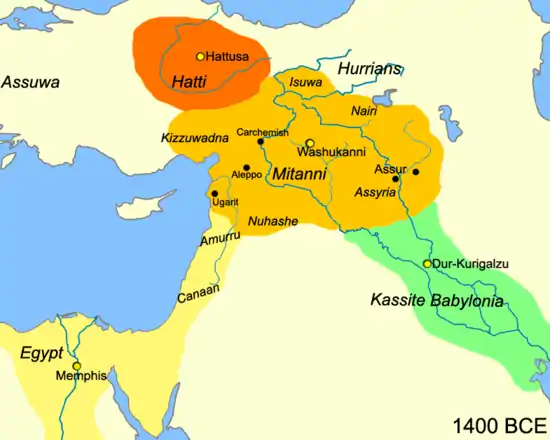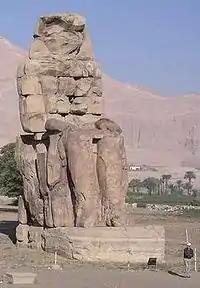14th century BC
The 14th century BC is a century that lasted from the year 1400 BC until 1301 BC.

Near East in 1400 BCE.
| Millennium: | 2nd millennium BC |
|---|---|
| Centuries: | |
| Timelines: | |
| State leaders: |
|
| Decades: | |
| Categories: | Births – Deaths Establishments – Disestablishments |
Events
- 1350 – 1250 BC: The Bajío phase of the San Lorenzo site in Mexico; large public buildings are constructed.[1]
- Pastoral nomadism develops in the steppes of Central Asia; cattle are watched on horseback.[2]
Middle East

The northern Colossus of Memnon
- 1400 – 1250 BC: The heyday of the Phoenician city of Ugarit.[3] A written alphabet is attested by Ugaritic texts.[4]
- c. 1380 – 1336 BC: The reign of Šuppiluliuma I, who leads the Hittite Empire to its peak.[5] Šuppiluliuma I conquers the weakened Hurrian kingdom of Mitanni in the second half of the century. Assyria is emancipated under Ashur-uballit I.[6]
- 1372 – 1350 BC: Akhetaton (Amarna) is constructed as the ephemeral capital of the pharaoh Akhenaten and dedicated to the sun god Aten. It is abandoned a few years after Akhenaten's death.[7]
- c. 1325 BC: Pharaoh Tutankhamun dies and is buried in a richly furnished tomb in the Valley of the Kings.[5]
- c. 1320 – 1295 BC: The sinking of the Uluburun shipwreck in the Mediterranean Sea south of modern-day Kaş.[8]
- Lycian pirates from southwest Anatolia raid the kingdom of Alashiya in Cyprus. They are employed as mercenaries by the Hittites and take part in the Battle of Kadesh.[9]
- An Ugaritic patera, with its embossed decoration in concentric zones and hunting scenes, reveals an exceptional level in goldsmithing.[10]
Europe
- c. 1400 – 1300 BC:
- A glacial rise is attested by the peat bog of the glacier of Tyrol.[11]
- Phase III A of the Greek Bronze Age.[12] Contacts with the Mycenaean civilization are established at Thapsos, Syracuse, Scoglio del Tonno in the Gulf of Taranto, and Ischia on the Tyrrhenian coast.[13][14]
- 1400 – 1370 BC: Phase III A1 of the Late Helladic period in Greece.[15] Palaces are constructed in Tiryns and Pylos.[16] Linear B, which transcribes an archaic form of Greek, appears in the palace of Knossos at the end of Phase III A1 of the Late Minoan period.[17]
- 1370 – 1340 BC: Phase III A2 of the Late Helladic period in Greece.[15]
- 1340 – 1190 BC: Phase III B of the Late Helladic period in Greece.[15] Beehive tombs are constructed in Epirus and Thessaly,[18] and a palace is constructed in Athens.[19]
- 1380 – 1120 BC: A Mycenaean sanctuary is built in Phylakopi.[16]
- c. 1370 BC: The Hagia Triada Sarcophagus is created in Crete.[20]
- c. 1350 – 1330 BC: The reconstruction of the palace and Cyclopean enclosure at Mycenae, then at its peak under the reign of the legendary king and queen Perseus and Andromeda.[21]
References
- Bricker, Victoria; Sabloff, Jeremy A. (2012). Supplement to the Handbook of Middle American Indians. Vol. 1. University of Texas Press. p. 376. ISBN 978-0-292-74441-7.
- Beaumont, Hervé (2008). Asie centrale (in French). Editions Marcus. p. 101. ISBN 978-2-7131-0228-8.
- Papin, Yves Denis (1998). Chronologie de l'histoire ancienne (in French). Éditions Jean-paul Gisserot. p. 12. ISBN 978-2-87747-346-0.
- Lalou, Frank (2016). Les 22 clés de l'alphabet hébraïque (in French). Desclée De Brouwer. p. 38. ISBN 978-2-220-02025-9.
- Roux, Georges (1995). La Mésopotamie (in French). Seuil. p. 559. ISBN 978-2-02-008632-5.
- Freu, Jacques; Mazoyer, Michel (2008). L'apogée du nouvel empire hittite (in French). L'Harmattan. p. 13. ISBN 978-2-296-21119-3.
- Simpson, William Kelly (1998). The Art and Architecture of Ancient Egypt. Yale University Press. p. 181. ISBN 978-0-300-07747-6.
- Fokkens, Harry; Harding, Anthony (2013). The Oxford Handbook of the European Bronze Age. OUP Oxford. p. 383. ISBN 978-0-19-957286-1.
- Demand, Nancy H. (2011). The Mediterranean Context of Early Greek History. John Wiley & Sons. p. 206. ISBN 978-1-4443-4234-5.
- Ottinger, Bénédicte (2002). L'art et la chasse (in French). Renaissance Du Livre. p. 12. ISBN 978-2-8046-0679-4.
- Vivian, Robert (2005). Les glaciers du Mont-Blanc (in French). La Fontaine de Siloë. p. 20. ISBN 978-2-84206-285-9.
- Baurain, Claude (1997). Les Grecs et la Méditerranée orientale : des siècles "obscurs" à la fin de l'époque archaïque (in French). Presses universitaires de France. p. 60.
- Mossé, Claude; Schnapp-Gourbeillon, Annie (2009). Précis d'histoire grecque (in French). Armand Colin. p. 69. ISBN 978-2-200-28392-6.
- Turfa, Jean MacIntosh (2014). The Etruscan World. Routledge. p. 198. ISBN 978-1-134-05523-4.
- Feuer, Bryan (2004). Mycenaean Civilization. McFarland. p. 6. ISBN 978-0-7864-2698-0.
- Poursat, Jean-Claude (2014). La Grèce préclassique (in French). Points. p. 49. ISBN 978-2-7578-4500-4.
- Viers, Rina (2000). Des signes pictographiques à l'alphabet : la communication écrite en Méditerranée : actes du colloque, 14 et 15 mai 1996, Villa grecque Kérylos, Fondation Théodore Reinach (Beaulieu-sur-mer) (in French). Karthala. p. 219. ISBN 978-2-86537-996-5.
- Platon, Nicolas; de Tournay, Béatrice (1981). La Civilisation égéenne : Le Bronze récent et la civilisation mycénienne (in French). Vol. 2. Albin Michel. p. 382. ISBN 978-2-226-22522-1.
- Étienne, Roland (2004). Athènes, espaces urbains et histoire (in French). Hachette Éducation. p. PT22. ISBN 978-2-01-181444-9.
- Suter, Ann (2008). Lament. Oxford University Press. p. 77. ISBN 978-0-19-971427-8.
- Faure, Paul; Gaignerot, Marie-Jeanne (1991). Guide grec antique. Hachette Éducation Technique. p. PT65. ISBN 978-2-01-181766-2.
This article is issued from Wikipedia. The text is licensed under Creative Commons - Attribution - Sharealike. Additional terms may apply for the media files.